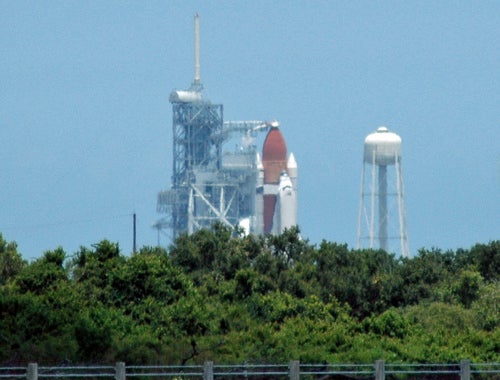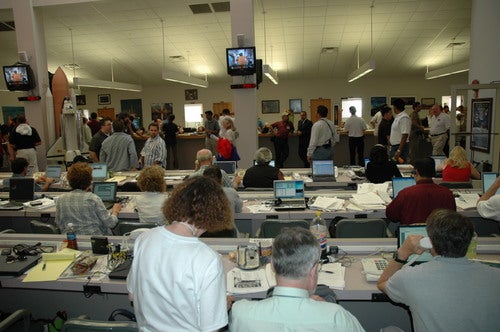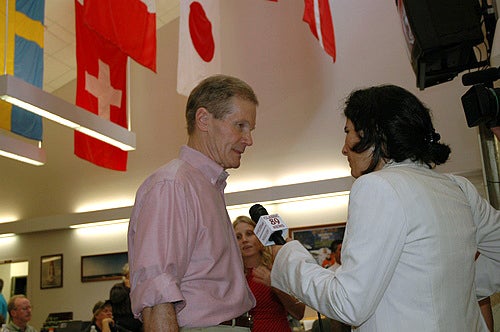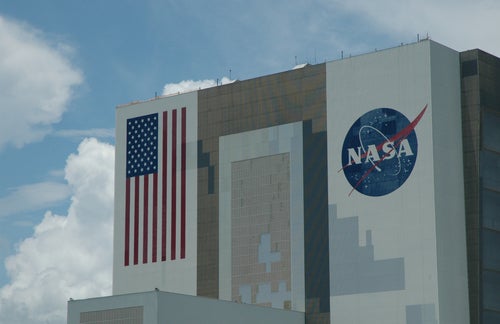For the second time in space-shuttle history, Discovery was the chosen vehicle for the system’s return to flight following a tragic accident. But the vehicle remains grounded because one of the shuttle’s low-hydrogen-fuel detectors — Engine Cutoff sensor (ECO) No. 2 — failed a pre-launch check. The fuel-sensor glitch remains unresolved, and hundreds of engineers across the country are working on the issue.
In a press conference Monday night, NASA said the shuttle will fly no earlier than Tuesday, July 26. Without what Hale calls “eureka moments,” the space agency’s next step is to refuel Discovery’s fuel tank to see if the problem surfaces again.
“Hopefully in the next 24 to 48 hours, we will find the glitch that has got us all confused or frustrated or — pick your adjective — and be able to fix it and go forward,” Hale says. “But I think Tuesday is probably the earliest day that we would be looking for a launch, even in that optimistic case.”
NASA scheduled the first return to flight in May of this year. Although fuel-sensor problems have plagued the vehicle since mid-April, engineers decided to change out the external tank due to a potential problem with icing on a flexible bellows carrying liquid oxygen from the external tank to the orbiter. This decision pushed the earliest launch date to July 13.
“The sensor failed in a way like the [tanking] test last May,” says Thomas Jones, a former astronaut and veteran of four missions, the last in February 2001 aboard space shuttle Atlantis. “Two different tanks, two different tests. They thought they had laid that issue to rest. The engineers must have a real sense of chagrin,” he tells Astronomy.
Ultimately, solving the problem may require NASA to look at the entire history of this sensor. “Did the manufacturer build this differently? Was there a new subcontractor involved? The problem may come down to these sorts of questions,” Jones says.
The ECO sensors prevent the shuttle’s main engines from shutting down too early or too late after launch. Since the 1986 Challenger disaster, NASA has requires all four sensors to be operating, instead of three out of four, but only two working sensors are needed to ensure safety. Mission managers have considered the possibility of falling back to the pre-Challenger rule, which would allow a launch even with the faulty sensor, Hale says, but they would prefer a fix.
Florida Senator Bill Nelson was on the scene last Wednesday. He flew on Columbia as payload specialist during STS-61C, from January 12 to 18, 1986. This, the 24th space-shuttle flight, was launched just 10 days before the Challenger accident. Nelson is an outspoken advocate for space exploration.
When asked if attempting a launch on a 13th could bring bad luck, ex-NASA chief Sean O’Keefe, who was at the Kennedy Space Center last week, countered, “NASA is not superstitious.”
Nevertheless, a series of events threatened to scrub Wednesday’s launch. Tuesday night, a taped-on temporary window cover fell off Discovery, struck its tail, and damaged thermal tiles there. Technicians immediately repaired the tiles.
Throughout launch day, there was a 40-percent chance sporadic bad weather — remnants of Hurricane Dennis, which tracked through the Gulf of Mexico last week — would delay the launch.
Ultimately, ECO sensor No. 2 inside the external tank failed a routine pre-launch check during countdown, leading NASA officials to cancel the launch.
NASA has until July 31 before the current launch window closes. After this date, the shuttle will remain on the ground until the next launch window opens, on September 9. Troubleshooting continues, but there is still no indication why the hydrogen sensor failed Wednesday. The crew remained at the Kennedy Space Center throughout the weekend in the event a quick fix materialized.
Discovery successfully completed the STS-26 shuttle mission two-and-a-half years after the 1986 Challenger accident. Last week on July 13, Discovery was scheduled to carry the STS-114 crew on NASA’s return-to-Flight mission to the International Space Station — some two-and-a-half years after the Columbia accident February 2003.













